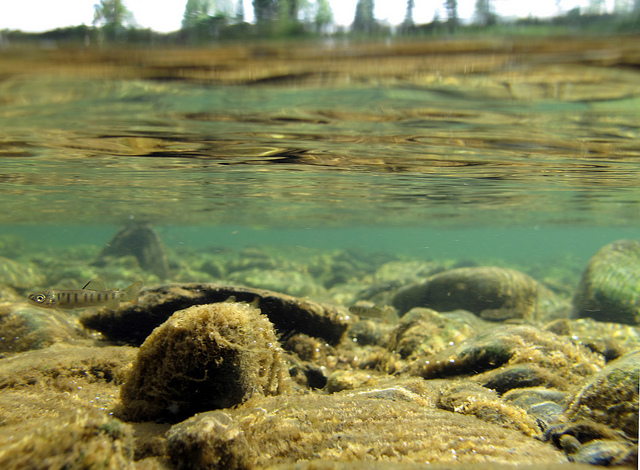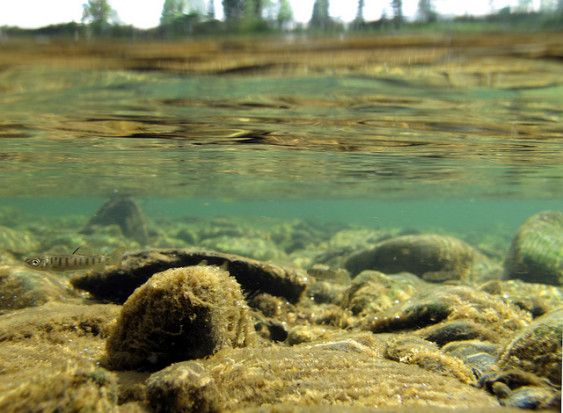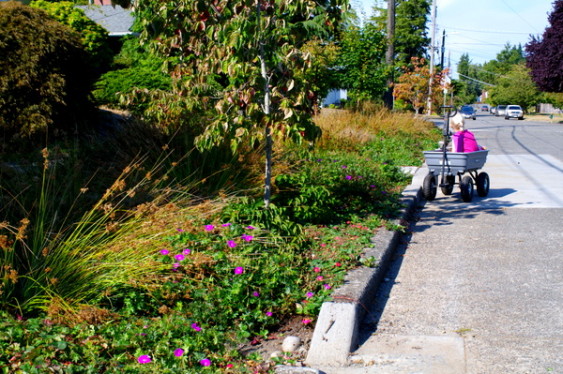Editor’s note: Planning on installing a rain garden this year? This popular article from last winter should give you that added boost of encouragement to take the plunge! (Our salmon will thank you.) More resources here, too!
When Northwest scientists collected rainwater runoff from Seattle’s Highway 520 and exposed juvenile salmon to the stormwater, all of the fish were dead within 12 hours.
But if they first treated the stormwater by running it through a column containing primarily sand, compost, and shredded bark—essentially a mini rain garden—the coho survived.
The researchers repeated the test with tiny crustaceans and mayfly nymphs, a favorite food of juvenile salmon. Again, the untreated water proved deadly while filtration through the faux rain garden removed enough pollution that the creatures survived.
“This is a simple approach that can make a big difference in the quality of water flowing into our rivers and streams,” said Jennifer McIntyre, postdoctoral researcher at Washington State University and lead author of the research, which is being published this month in the journal Chemosphere.
“In this case, the salmon and their prey are telling us how clean is clean enough,” said McIntyre in press release.
When rain falls on roadways, parking lots, and rooftops, it can’t soak into these hard surfaces, so it streams across them, picking up oil and grease, heavy metals, pesticides, and other toxic chemicals. It carries the pollutants into streams and gutters that flow directly into Puget Sound and other sensitive waterways.
Green stormwater solutions, including rain gardens and bioswales (rain gardens’ more heavily engineered cousins), absorb the runoff, reducing the volume of stormwater and stripping the pollution out of it.
McIntyre and other researchers found that by filtering the runoff through the columns it reduced the amount of metals in the water by 30 to 99 percent. Polycyclic aromatic hydrocarbons (PAHs), created by the combustion of gasoline, wood, and other fossil fuels, were largely eliminated. The results corroborate earlier research showing that soil, bacteria, sand, plants, and other elements of rain gardens capture and treat many of the pollutants.
Filtering #stormwater runoff reduces its metals content by 30-99%.
“The positive effects on survival are really striking,” said Nat Scholz, manager of the Ecotoxicology Program at NOAA Fisheries’ Northwest Fisheries Science Center and a coauthor of the research, in a press release. “This is an encouraging lesson for people working to reduce stormwater impacts to salmon habitats.”
Across the Northwest there is a movement to install more rain gardens and green stormwater technologies, which also include green roofs and permeable pavement, as well as protecting native vegetation and shrinking the amount of water-repelling impervious surfaces being built. In Washington, the state Department of Ecology has rules for cities and counties that require the increased use of green solutions while the voluntary 12,000 Rain Gardens program encourages private landowners to manage their stormwater.
The columns used to treat the runoff in the experiments measured roughly 14 inches in diameter and contained a two-feet-deep soil mixture that was 60 percent sand, 15 percent compost, 15 percent shredded bark and 10 percent drinking-water treatment residuals from the nearby city of Anacortes. The sand component helps with the drainage and filtering, while the compost provides nutrients needed by plants and trees and can help capture pollutants. Underneath the soil mixture was about a foot of gravel for drainage. Half of the 12 columns were planted with sedges, though the grassy plants didn’t appear to have much effect on the results.
The columns are a fair approximation of a Northwest rain garden. In Washington, the state’s official rain garden guide and its 2012 LID Technical Guidance Manual for Puget Sound include recommendations for the “bioretention soil mix” used in rain gardens. The mix calls for 60 to 65 percent sand or soil excavated from the site, and 35 to 40 percent compost.
The study’s authors concluded that their experiments provide a scientifically sound endorsement of green stormwater solutions, stating:
Overall, these results demonstrate that bioretention can achieve a central aim of green stormwater infrastructure; namely, preventing harm to aquatic animals.












Scott Foster
Thank you, Lisa, for the positive article. The Rainwise and 10,000 Rain Gardens programs are good first steps. Rain gardens do help reduce runoff, mitigating negative effects of development on our waterways. They work where they will infiltrate in available landscape.
The next step is to get runoff from roadways, driveways, and other pollution generating surfaces into feasible rain garden plots. The cities of Seattle, Sammamish, and other jurisdictions have some good local examples – like you’ve pictured.
Now, how do we treat the runoff from 520? How many square feet of two-foot deep media would be needed? How many square acres?
I’m trying to work out how to retrofit developed stream basins to incorporate stormwater LID best management practices. I find that a lot of the properties that are vacant are not developed because they do not percolate well, or they are wetlands. Public right-of-way is often encumbered by other needs set on them – turning radius for a fire truck or school bus, public sidewalks, bike lanes.
Feedback here on how to drain the landscape of roadways to rain gardens would be welcome. Thanks!
Dick Schaetzel
Scott,
When SR 520 was widened a few years ago WSDOT installed an Ecology Embankment on the north side of the hiway. Although the EE has been used with apparent success on SR 167 (and highly monitored), the new EE on 520 was only the second time that technology had been used in our state. We at Water Tenders wanted to make sure that Bear Cr. was being protected by the EE. It worked pretty well with the within the limited parameters we could afford. Copper is still a problem. If you search WSDOT’s website you can get detailed info on the contents of the EE and test results.
The abridged test results we had on 520 can be found on our website. Go to the newsletter button and search Fall/Winter 2010 and Spring/Summer 2012.
David Hymel
Thank you Lisa for translating the science and Scott for your great question. Our team developed the Splash Boxx bio retention planter system precisely for the conditions that Lisa has described and to answer the obvious question that Scott raises – how to treat roadways. Splash Boxx uses the same soil mix approved by Department of Ecology in a steel roll off container, which is pre-engineered so that we know exactly how many Boxxes are required for a defined roadway area. We can do acres of impervious surface treatment, and a typical installation is just a few hours. Splash Boxx is currently treating stormwater from roof areas at the Ports of Tacoma and Seattle. At Port of Seattle’s Pier 91, we are also testing a pair of Boxxes. One ueses a rain garden mix that replaces riverine sand common in most rain gardens with volcanic sand quarried in Eastern Washington. This is part of the Moving Green Infrastructure Forward (MGIF) project co-sponsored by the Port of Seattle, King Conservation District and Sustainable Seattle. You can find details of that project, including an installation video, at http://www.ecobuilding.org/code-innovations/case-studies/moving-green-infrastructure-forward-mgif-using-splash-boxx-a-portable-bio-retention-planter-box. We offer a Boxx that we can relocate to treat and test water from an elevated roadway such as Hwy 520 or the Alaskan Way Viaduct. We are looking for a suitable location, a site host and project sponsors that would be willing to help us field demonstrate what the authors of the study have said is possible. Perhaps Scott, Lisa and SightLine readers can assist.
Amy Waterman
In working to find a site for the above-mentioned Moving Green Infrastructure Forward project, one challenge for treating runoff from roads came to light. I was speaking with Washington DOT about using their ultra urban stormwater research facility our research/demonstration project. This facility was designed to treat much larger volumes of runoff than two Splash Boxxes could handle. But, in addition, DOT staff said it was difficult to estimate the exact volume of storm water from each catch basin, since they easily got clogged and subtle differences in roadway surface changed the drainage pattern (presumably for small storms especially). Since the majority of our storms involve light rain, this could be a challenge for estimating the runoff from a particular section of roadway with a set number of catch basins.
Amy Waterman
Forgot to add our website 😉
Jessalan
Great information on helping the Salmon and with better water runoff. It is sad, to think about dirty water causing issues with wildlife and in the long term likely humans as well. I am not sure what the DOT is doing about run off from Minneapolis lawns
and urban sprawl. It would be interesting to look into that.
Jay Allen
It is good to see some DOT and other groups are discussing the plight of the Salmon. It is good if we can take positive actions to improve the quality of water and impact the lives of various animals that need clean water to live. It will take education online and offline to let people know how to make this happen.